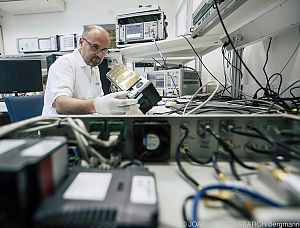Styrian Space Technology - Pioneering W-Band Frequencies from Space

These are transmitted by the CubeSat, which launched into polar orbit on June 30, 2021, as part of the payload aboard a Falcon 9 rocket from Cape Canaveral. The mission's goal is to transmit W-band signals from the satellite and generate new knowledge about the atmospheric effects of radio signal propagation in such a high frequency band.
The capacity requirements for data transmission are increasingly growing today. Research is being conducted worldwide on new data highways for digital consumption. In addition to ever stricter regulations, people are also moving to ever higher frequencies. To connect the new powerful satellites to the Internet, new frequencies - such as 75 and 37.5 GHz - are now being tested. It sounds simple, but it's complex because the short wavelengths are heavily influenced by weather patterns and not every frequency range is suitable for transmission. "So in a way, there is a race to see who can take advantage of the very high frequencies sooner," explains DIGITAL research group leader Michael Schönhuber.
While the so-called Ka-band frequencies (20/30 GHz) are already in operation, there are some research activities and experimental satellite payloads in the Q/V-band range (40/50 GHz). The W-band (75-110 GHz) was a pipe dream until recently. "Although there have been attempts by international players, no results are known yet," explains Schönhuber, an expert in space communications. With the reception and the start of the evaluations, the Graz researchers are doing pioneering work together with the international project team: "The measurement phase starts now with the first signals we receive from the CubeSat. We need to understand the new band in order to make the best use of it. With the results, it will be possible to create models to enable the dimensioning of satellite links and to carry out operations efficiently," says project manager Michael Schmidt. "We have entered new technological territory and are thus at the forefront in Europe," says a delighted Michael Schönhuber.
The development of the CubeSat took place in Finland - Michael Schmidt of DIGITAL, JOANNEUM RESEARCH's Institute for Information and Communication Technologies, is leading the ESA project. The CubeSat will be visible from Graz five to six times a day. The receiving antenna was developed by project partner Luis Cupido Technologies, the satellite by Reaktor Space Lab, Fraunhofer and VTT Technical Research Centre of Finland, and the data received will be analyzed by the JOANNEUM RESEARCH team and the University of Stuttgart.
Michael Schmidt has been working in the field of satellite communications for 25 years and has been involved in many ESA projects. Thus, the successful development, construction and operation of the satellite ground station "Hilmwarte" in Graz was also carried out under his leadership. At the Hilmwarte in Graz, important findings were made in the field of measuring the attenuation of satellite signals and methods were developed to compensate for this attenuation.
Funding
The project was funded by the Austrian Federal Ministry for Climate Protection, Environment, Energy, Mobility, Innovation and Technology with about 1 million Euro after a competitive tender. The funding is provided by the Austrian Research Promotion Agency (FFG) within the framework of an ESA project. In the project, the Aerospace Agency of FFG is thus responsible for the largest single funding. The countries Finland, Germany and Portugal also supported the project with a total of 2 million euros.
